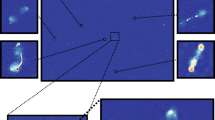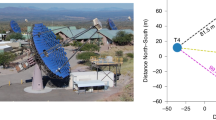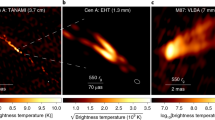Abstract
IN previous experiments at Jodrell Bank the angular sizes of discrete radio sources have been investigated by means of long baseline interferometers1,2. The highest resolving power used previously was obtained during observations at a wave-length λ = 0.73 m with telescopes 180,000 wave-lengths apart (134 km). Four quasi-stellar and one unidentified source were found to be unresolved in those observations. Their angular sizes were thus shown to be smaller than 0.4 sec of arc. In a further attempt to resolve these sources another experiment has been carried out using the Mark I 250-ft. radio telescope at Jodrell Bank, and one of the 82-ft. radio telescopes operated by the Royal Radar Establishment, Malvern. The separation of these telescopes is 127 km, in a direction which is close to north–south. This interferometer worked on a wave-length λ = 0.21 m, so that the maximum resolving power was more than three times greater than had been obtained in the previous observations. The effective resolving power changes as sources are observed in different directions, but its maximum value is greater than 600,000 wave-lengths for most sources. With this baseline the output fringe frequency produced as the radio source moves through the lobes of the interferometer pattern varies with hour angle from 0 to as much as 40 c/s. An almost identical frequency was produced continuously by a digital ‘fringe speed machine’ and this was subtracted from, the interferometer output, so that the fringe patterns displayed on the chart recorder were normally slower than 0.5 cycles/min. A microwave link system was established between the two observatories, via two repeater stations. A new very-high-frequency phase-locking system was also developed, with equipment at each site.
This is a preview of subscription content, access via your institution
Access options
Subscribe to this journal
Receive 51 print issues and online access
$199.00 per year
only $3.90 per issue
Buy this article
- Purchase on Springer Link
- Instant access to full article PDF
Prices may be subject to local taxes which are calculated during checkout
Similar content being viewed by others
References
Allen, L. R., Anderson, B., Conway, R. G., Palmer, H. P., Reddish, V. C., and Rowson, B., Mon. Not. Roy. Astro. Soc., 124, 477 (1962).
Anderson, B., Donaldson, W., Palmer, H. P., and Rowson, B., Nature, 205, 375 (1965).
Dent, W. A., Science, 148, 1458 (1965).
Schmidt, M., Astrophys. J., 141, 1295 (1965).
Shklovsky, I. S., Astro. Circ., U.S.S.R., No. 250 (1963).
Hoyle, F., and Burbidge, G. R. (personal communication).
Anderson, B., Ph.D. thesis, Univ. Manch. (1965).
Conway, R. G., Kellerman, K. I., and Long, R. J., Mon. Not. Roy. Astro. Soc., 125, 261 (1963).
Ryle, M., Elsmore, B., and Neville Ann, C., Nature, 207, 1024 (1965).
Author information
Authors and Affiliations
Rights and permissions
About this article
Cite this article
ADGIE, R., GENT, H., SLEE, O. et al. New Limits to the Angular Sizes of Some Quasars. Nature 208, 275–276 (1965). https://doi.org/10.1038/208275a0
Issue Date:
DOI: https://doi.org/10.1038/208275a0
This article is cited by
-
Radio emission of CTA 21 and CTA 102 in the meter range
Astrophysics (1968)
-
Discrete Radio Sources at 38 Mc/s
Nature (1967)
-
Radio Emission from the Sources 3C 225 and 3C 267
Nature (1967)
-
Radio Diameter Measurements with Interferometer Baselines of One Million and Two Million Wavelengths
Nature (1967)
-
Inverse Compton Effect in Quasars
Nature (1966)
Comments
By submitting a comment you agree to abide by our Terms and Community Guidelines. If you find something abusive or that does not comply with our terms or guidelines please flag it as inappropriate.



